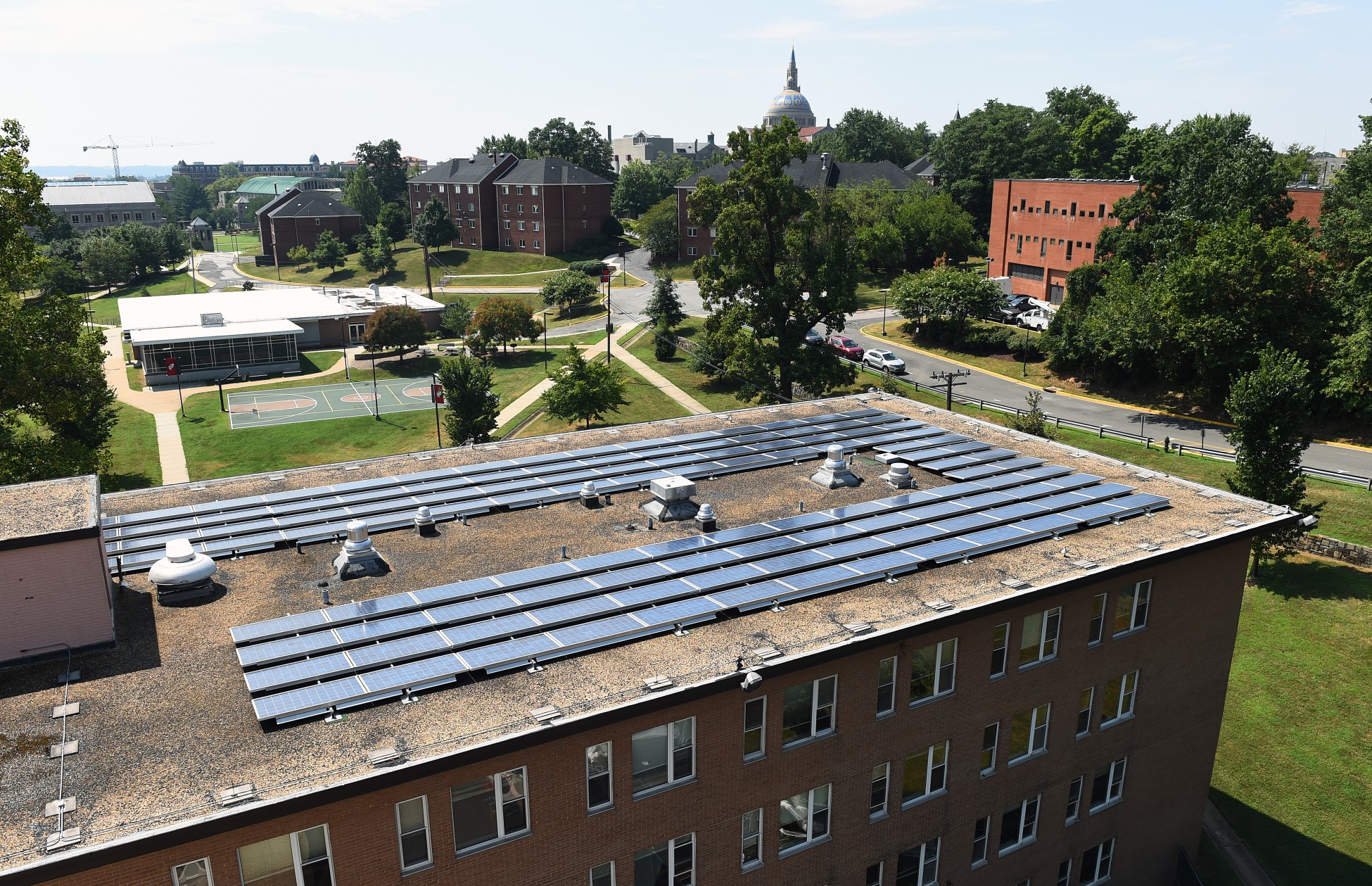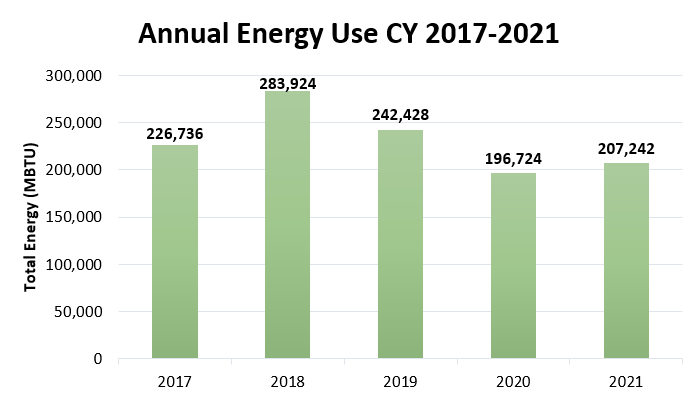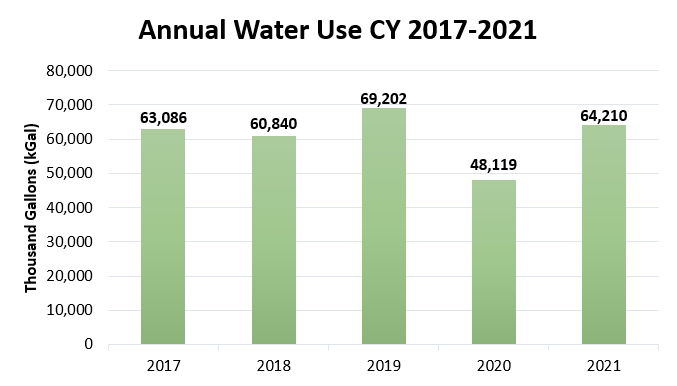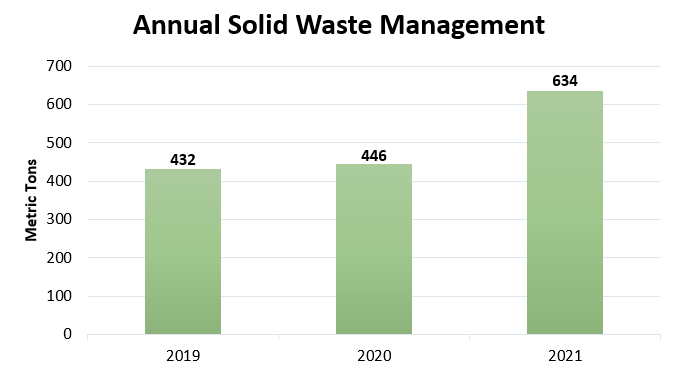
By Julianna Okupski, March 2022
To understand Catholic University’s environmental impact, the Facilities Planning and Management team continuously measures campus utilities. The goal of this blog post is to present a clear picture for the campus community on utility usage and metrics. This enables transparency and advocacy for solutions to reduce utility use, resulting in a variety of benefits for the campus community.
The Office of Campus Sustainability breaks down utility data into water, natural gas, electricity, waste (including recycling), and greenhouse gas emissions and analyzes the trend over a five-year period (2017-2021). The data for 2021 reflects the impact of the substantial completion of the Energy Project in 2020 and the increase in campus operations after the pandemic.
This blog post highlights big picture energy, water, and waste metrics that the office uses to gain insight into campus operations and support decision making.
Data Anomalies
By the end of 2020, staff and faculty began phasing back to campus with approximately 600 students residing on campus and 25% of staff and faculty on campus. With that, about two-thirds of residential buildings remained operational. The reduced campus population and operational buildings led to a noticeable decrease in energy and water use in 2020.
Catholic University enthusiastically welcomed back all students and faculty in 2021. Thankfully, campus life has been lively and active and our campus community is starting to return to where it was pre-pandemic. Even with the influx of students living in dorms and campus activities, Catholic University has been able to not only manage its energy, water, and waste use but has noticeably decreased usage.
The gradual decrease in energy, water, and waste usage on campus is an encouraging sign of Catholic University’s commitment to its environmental impact. Hopefully, the campus will maintain this decrease with the continued implementation of the Sustainability Plan (2021-2025).
To achieve the goals outlined in the Sustainability Plan and make long-lasting impactful changes, coordinated action is needed from all students, faculty, and staff. These goals are meant to challenge all Catholic University community members to take any action, whether big or small, to transform the University into a truly sustainable campus.
Energy
Energy use accounts for the majority of campus utilities. The energy required to power all heating, ventilation, and air-conditioning (HVAC) campus equipment is supplied either through electricity or natural gas. Natural gas is used primarily for powering boilers and other steam system components that warm buildings on campus. Electricity is used primarily for cooling, lighting, and powering general appliances and computers.

Trends. There was a clear increase in energy use from calendar year 2017 to 2018. However, since 2018, there has been a gradual decrease in energy use which continued into 2020. The decrease in 2020 was largely due to the decrease in occupancy on campus due to the pandemic. In 2021, we started seeing an increase in energy use because faculty, staff, and students returned to campus on a more regular schedule, which followed the trend of the COVID-19 pandemic restrictions lifting. However, energy use in 2021 still reflected a 15% decrease compared to pre-pandemic levels in 2019.
Goal. By fiscal year 2025, the University aspires to reduce energy use by 20% compared to 2016, which is equivalent to saving 49,943 MBTUs. This is equivalent to the CO2 emissions from 760,932 gallons of gasoline consumed or the greenhouse gas emissions from 1,436 vehicles driven for a year.
Ideas for Saving Energy
To help us achieve this goal, students can make minor changes to their daily habits to save energy:
- Take the stairs instead of using the elevator. It is a small but effective way to not only save energy but improve your health.
- Take a walk around campus once a day. It will reduce your screen/lighting time and provide you with some fresh air.
- Turn off lights and use natural lighting in the residence halls. This reduces lighting time and is better for mental health.
Water
On campus, water is used for faucets, toilets, and showers as well as to heat and cool buildings on campus due to the recent modifications made by the Energy Project. The Energy Project also introduced a stormwater harvesting cistern and filtration system to collect rainwater for use in the campus’ three cooling towers. These towers can hold up to 15,000 gallons of water, with expected savings of 270,226 gallons per year.

Trends. Water use was consistent from 2017 to 2018, but increased slightly in 2019. In April and May of 2020, there was a significant decrease in water use, which can be attributed to the beginning of the COVID-19 pandemic which sent faculty, staff, and students home. Water use increased by 170% in April 2021 compared to April 2020 which can be attributed to the return of campus activity. However, water use in 2021 still reflected a decrease of 6% compared to pre-pandemic levels in 2019.
Goal. By fiscal year 2025, the university aspires to reduce water use by 20% compared to 2016, which is equivalent to 14,643 kGals saved; enough water to fill 22 Olympic-sized swimming pools.
Ideas for Saving Water
To help us achieve these savings, students can make small changes to reduce their water use:
- Turn off the tap while you brush your teeth to save one to two gallons of water per minute of brushing.
- Challenge yourself to spend 1-2 minutes less in the shower per day to save five gallons of water per minute.
Waste
Waste refers to all items discarded and removed from the University, including recycling, compost, and trash. The Pryzbyla Center contains three-way separation bins for trash, recycling, and compost. Elsewhere on campus, you can find trash and recycling bins dispersed throughout the residence halls, administrative buildings, and academic buildings.
All recycling collected on campus is single-stream recycling. This refers to a system in which all paper, cardboard, plastic, metal, and glass are placed in one bin, instead of being allocated into separate receptacles and handled separately throughout the collection process. Since it is easier to recycle with a single-stream system, it promotes recycling participation and also decreases greenhouse gas emissions and recycling costs. However, single-stream recycling also increases the possibility of contamination so it is imperative to properly sort your waste on campus.
-
Fight Contamination in the Bin
Catholic University is working to promote proper waste management and sorting on campus. The three-way separation bins in the Pryz, for recycling, compost, and trash, and the trash and recycling bins across the rest of campus, are only successful as long as the campus community sorts waste correctly. If the recycling or compost bins are contaminated with trash, then the whole bin is disposed of as trash.
It is crucial for students, faculty, and staff to know how to properly sort waste. Review the recycling and composting signs above each bin to learn what goes where and play our new waste sorting game for recycling and composting tips.

Trends. University waste data is available starting in 2019. From 2019 to 2020, we saw a slight increase in waste, which can be attributed to the increased use of masks, cleaning supplies, and single use items during the COVID-19 pandemic. This continued from 2020 into 2021, where we saw a more significant increase in the amount of waste on campus, due to the increase in personal waste as a result of the pandemic in addition to the resumption of normal activities on campus. Similarly, the diversion rate of waste has steadily decreased throughout the past three years. In 2019, there was a 30.46% diversion rate, in 2020 there was 30.35% diversion rate, and in 2021 there was a 21.40% diversion rate.
Goal. By 2025, the university aspires to divert 50% of waste generated on campus from landfill. This is equivalent to removing 700 tons from the landfill and the carbon emissions generated by 143,048 hours of electricity or 25,871 gallons of oil.
Ideas for Reducing Waste
To help us get back on track with our diversion rate and achieve our 50% goal, there are many ways students can help reduce waste on campus:
- Invest in a reusable water bottle. This could save approximately 156 single-use water bottles each year.
- Invest in reusable straws and cutlery rather than using disposable straws, forks, knives, and spoons.
- In residence halls, use reusable wash clothes and toiletries products.
- If you own furniture, clothes, or decorations that break, try to fix the item instead of discarding it and buying a new one. You might even learn a new skill!
